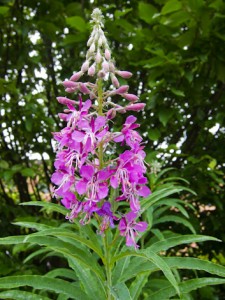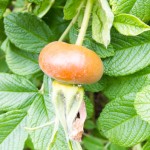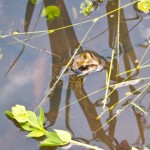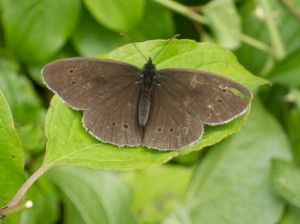I haven’t put any observations up in the last few weeks. There is no particular reason for this, at least it is not due to a lack of nature. Despite the hot, sunny weather and lack of rain for the last month, there is still a lot of wildlife out there, although there are reminders that autumn is not far away.
 Unlike the plants in my garden, a lot of the wildflowers still seem to be surviving, although, as expected these are mainly the perennials. A lot of the grasses are now looking as though they are living in Texas, not in Daventry, and the usually green and pleasant land is turning distinctly straw-coloured. The flowers that seem to be doing well at the moment are the yellow ragwort, purple thistles, and the statuesque Rosebay Willowherb. This is a plant that has spread rapidly since the introduction of the railways and is present on almost all railway embankments that I have seen, along with motorway verges. It is also called fireweed due to its colonisation of areas destroyed by fire. In the autumn you will see thousands of the seeds carried on the wind, helping it to spread. However, in spite of its encroaching nature, I think that, close-up it is a remarkably pretty flower, and, as a wildflower, is a food source for many insects. The plant also has culinary uses, its roots have been used in stews and it leaves in salads, being valued as a source of Vitamins A and C.
Unlike the plants in my garden, a lot of the wildflowers still seem to be surviving, although, as expected these are mainly the perennials. A lot of the grasses are now looking as though they are living in Texas, not in Daventry, and the usually green and pleasant land is turning distinctly straw-coloured. The flowers that seem to be doing well at the moment are the yellow ragwort, purple thistles, and the statuesque Rosebay Willowherb. This is a plant that has spread rapidly since the introduction of the railways and is present on almost all railway embankments that I have seen, along with motorway verges. It is also called fireweed due to its colonisation of areas destroyed by fire. In the autumn you will see thousands of the seeds carried on the wind, helping it to spread. However, in spite of its encroaching nature, I think that, close-up it is a remarkably pretty flower, and, as a wildflower, is a food source for many insects. The plant also has culinary uses, its roots have been used in stews and it leaves in salads, being valued as a source of Vitamins A and C.
 My favourite rose is now reaching the end of its flowering period, and round, fat rose hips are starting to appear on rosa rugosa, reminding me that autumn is not too far away. These are also a good source of Vitamin C as are most rosehips, and are often collected to make rosehip syrup.
My favourite rose is now reaching the end of its flowering period, and round, fat rose hips are starting to appear on rosa rugosa, reminding me that autumn is not too far away. These are also a good source of Vitamin C as are most rosehips, and are often collected to make rosehip syrup.
For the last month I have been wondering what has happened to all of the butterflies, there don’t seem to be many at all. I am eagerly awaiting the flowering of the buddleia to see if this will bring them out. However, I have seen a large number of dark, restless butterflies, flitting along the grasses in the Country Park and the hedgerows in the industrial estate. These are ringlet butterflies, and they are not always co-operative when trying to take photos! Their favourite nectar sources are bramble and privet flowers, which explains their appearance at this time of year when the hedgerows are full of these flowers (the smell of the privet is lovely at the beginning of the July).
The bees have all been busy in the garden, although I think they are lamenting the passage of the sage flowers. Our verbena bonariensis is not as prolific this year, and, as I noted earlier, the buddleia is not yet out, so they are having to content themselves with thyme and oregano as well as the last of the honeysuckle. Red tailed bumblebees (which happen to be my favourite) are in the garden each day, along with others that I think are buff-tailed and garden bumblebees, but I am still working on my identification skills.
This time of year also sees the skies starting to fill with house martins and swifts. The family groups feeding in the long evenings, but again, they will soon be gone. In the garden we have had several goldfinch chicks, and incredibly noisy they are too! They sound a little like a computer game, chirping and whirring.
 The garden is remaining remarkably resilient in the dry, parched weather (I rarely water anything in the garden, it can fend for itself), but the pond is getting incredibly low. We have discovered that we have at least one frog in the garden, and I am now happy in the knowledge that the pond is home to more than just and abundance of water snails. I assume that the frogs and toad spend a lot of their time in the vegetation around the garden.
The garden is remaining remarkably resilient in the dry, parched weather (I rarely water anything in the garden, it can fend for itself), but the pond is getting incredibly low. We have discovered that we have at least one frog in the garden, and I am now happy in the knowledge that the pond is home to more than just and abundance of water snails. I assume that the frogs and toad spend a lot of their time in the vegetation around the garden.
